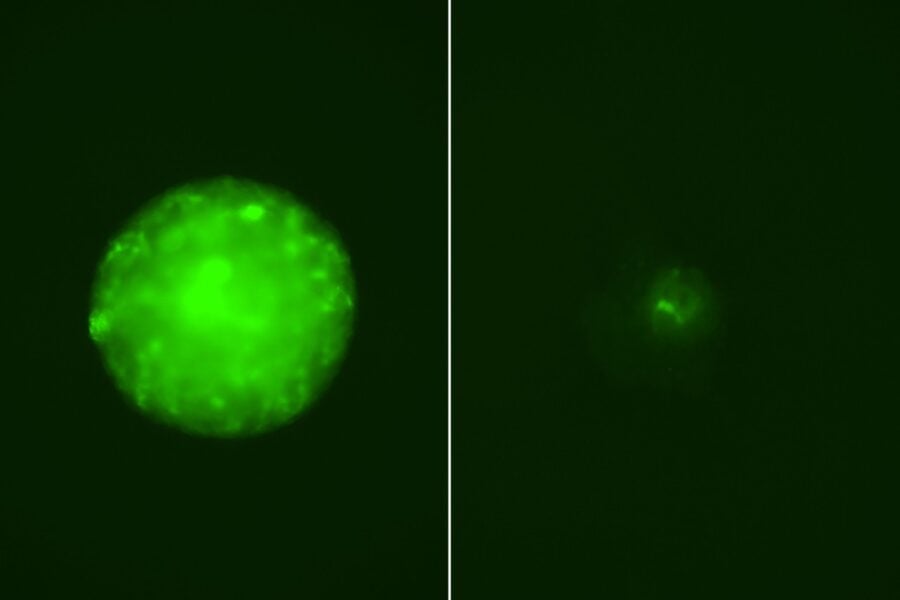UCLA scientists have developed a pioneering approach that combines genetic analysis with real-time observation of cancer cell behavior, offering new possibilities for treating glioblastoma, one of the most lethal forms of brain cancer. This innovative method could finally crack the code of this notoriously treatment-resistant disease.
Published in Nature Communications | Estimated reading time: 6 minutes
Imagine trying to defeat an enemy that constantly changes its battle strategy. That’s the challenge doctors face when treating glioblastoma, an aggressive brain cancer that routinely outsmarts current treatments. But now, UCLA researchers have developed a sophisticated new approach that combines two powerful tools – genetic profiling and functional analysis – to predict and overcome the tumor’s defensive tactics.
“Many cancer treatments are based on the genetic profile of a patient’s tumor. However, genomic features alone can’t always predict how a tumor will respond to a therapy,” explains Dr. David Nathanson, the study’s senior author and professor at UCLA. “This study explores a new approach that looks beyond the tumor’s genetic blueprint, in which we combine genetic data with functional tests to show how live cancer cells respond to treatments.”
At the heart of the discovery is a novel machine-learning tool called GAVA, which analyzes both a tumor’s genetic makeup and its real-time behavior. Using a technique called BH3 profiling, the team observed how cancer cells respond to treatments designed to trigger cell death, a process that glioblastoma cells typically resist.
The research revealed that standard therapies like radiation or chemotherapy can alter how the tumor’s self-destruct mechanism works, but this effect depends on specific genetic features, such as having a functional p53 gene. This insight led to testing ABBV-155, an experimental drug that targets BCL-XL, a protein that helps cancer cells avoid death.
The results were remarkable. “We found that combining standard therapies with ABBV-155 successfully induced tumor shrinkage, which is something we rarely observe in clinically relevant glioblastoma models,” notes Nathanson. This observation is particularly significant given glioblastoma’s notorious resistance to treatment.
Dr. Timothy Cloughesy, distinguished professor of neuro-oncology at UCLA and study co-author, emphasizes the implications: “The findings provide a clear path toward developing targeted, patient-specific therapies that could significantly improve outcomes for patients diagnosed with glioblastoma.”
The team is now preparing to test this promising combination therapy in clinical trials, offering new hope for patients facing this devastating diagnosis.
Glossary:
- Glioblastoma
- An aggressive form of brain cancer known for its resistance to treatment and ability to adapt to therapies.
- Genetic Profiling
- Analysis of a tumor’s DNA to identify specific mutations that might influence its behavior and response to treatment.
- Functional Profiling
- Real-time observation of how cancer cells respond to various treatments, providing dynamic insight into their behavior.
- BCL-XL
- A protein that helps cancer cells avoid death, making it a key target for new therapeutic approaches.
What makes this new approach to treating glioblastoma different from traditional methods?
It combines genetic profiling with functional analysis to observe how cancer cells respond to treatment in real-time, rather than relying solely on genetic information.
What is GAVA and what does it do?
GAVA is a machine-learning tool that combines genetic and functional data to predict how glioblastoma tumors might respond to specific treatment combinations.
What role does the protein BCL-XL play in glioblastoma?
BCL-XL helps cancer cells avoid death, making it an important target for new treatments.
What was the significant finding when combining standard therapies with ABBV-155?
The combination successfully induced tumor shrinkage, a rare observation in glioblastoma models.
Enjoy this story? Subscribe to our newsletter at scienceblog.substack.com
If our reporting has informed or inspired you, please consider making a donation. Every contribution, no matter the size, empowers us to continue delivering accurate, engaging, and trustworthy science and medical news. Independent journalism requires time, effort, and resources—your support ensures we can keep uncovering the stories that matter most to you.
Join us in making knowledge accessible and impactful. Thank you for standing with us!

